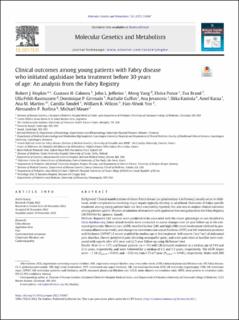| dc.description.abstract | Background
Clinical manifestations of classic Fabry disease (α-galactosidase A deficiency) usually occur in childhood, while complications involving major organs typically develop in adulthood. Outcomes of Fabry-specific treatment among young patients have not been extensively reported. Our aim was to analyze clinical outcomes among patients aged 5–30 years at initiation of treatment with agalsidase beta using data from the Fabry Registry (NCT00196742, sponsor: Sanofi).
Methods
Reported GLA variants were predicted to be associated with the classic phenotype or not classified in fabry-database.org. Linear mixed models were conducted to assess changes over ≥2-year follow-up in the estimated glomerular filtration rate (eGFR) stratified by low (LRI) and high (HRI) renal involvement (defined by proteinuria/albuminuria levels), and changes in interventricular septal thickness (IVST) and left ventricular posterior wall thickness (LVPWT) Z-scores stratified by median age at first treatment. Self-reports (‘yes’/‘no’) of abdominal pain, diarrhea, chronic peripheral pain (denoting neuropathic pain), and acute pain crises at baseline were compared with reports after ≥0.5-year and ≥2.5-year follow-up using McNemar's test.
Results
Male (n = 117) and female patients (n = 59) with LRI initiated treatment at a median age of 19.9 and 23.6 years, respectively, and were followed for a median of 6.3 and 5.0 years, respectively. The eGFR slopes were −1.18 (Pfrom 0 <0.001) and −0.92 mL/min/1.73 m2/year (Pfrom 0 = 0.040), respectively. Males with HRI (n = 23, median UPCR 1.0 g/g), who started treatment at a median age of 26.7 years, had an eGFR slope of −2.39 mL/min/1.73 m2/year (Pfrom 0 <0.001; Pdifference = 0.055, as compared with the slope of −1.18 mL/min/1.73 m2/year for LRI males) during a median follow-up of 5.6 years. Echocardiographic variables were stable among males, regardless of age, and among young females (median follow-up >5.5 years and ≥4.5 years, respectively). Older females (treatment initiation at median age 27.5 years) had a slope of LVPWT Z-scores of 0.18/year (n = 12, Pfrom 0 = 0.028), whereas IVST Z-scores remained stable (n = 13, 0.10/year, Pfrom 0 = 0.304) during a median follow-up of ≥3.7 years. These slopes did not significantly differ from slopes of younger females. Reports of chronic peripheral pain and acute pain crises by males, and of diarrhea and acute pain crises by females, significantly reduced after a median follow-up of ≥4.0 years. After a median follow-up of ≥5.4 years, reports of all four symptoms significantly decreased among males, whereas among females only reports of abdominal pain significantly decreased.
Conclusions
During sustained treatment with agalsidase beta in young Fabry patients with a predicted classic phenotype or with unclassified GLA variants with similar characteristics, the decline in eGFR was modest among male and female patients with LRI. The greater decline in eGFR among older, proteinuric (i.e., HRI) males may suggest a benefit of earlier treatment. Overall, echocardiographic variables remained stable, particularly among males and younger females. Significant reductions in symptom reports occurred primarily among males after longer follow-up and were less noticeable among females. These observed trends are suggestive of an overall improvement after treatment in young patients, but warrant larger longitudinal studies. | en_US |

